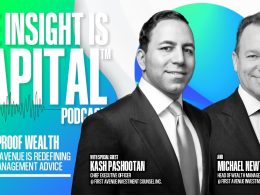Adding Value Through Asset Location Optimization
by Commonwealth Financial Network
 As a financial advisor, you know your job keeps getting tougher. It’s not enough that you play many roles: trusted advisor, educator, planning facilitator, portfolio manager, cross-generational family coordinator, and even friend. In this ever-changing industry, you must also find ways to set yourself apart. One solution? Prioritize asset location optimization in your practice.
As a financial advisor, you know your job keeps getting tougher. It’s not enough that you play many roles: trusted advisor, educator, planning facilitator, portfolio manager, cross-generational family coordinator, and even friend. In this ever-changing industry, you must also find ways to set yourself apart. One solution? Prioritize asset location optimization in your practice.
You may be asking, what does this really mean? To help you better understand asset location optimization, here I’ll explain what it is, whether it can improve your value-add as an advisor, and how one technology solution developed by Commonwealth is making this complex task easier for our advisors.
Simply put, asset location optimization is the process of disbursing assets from a client’s portfolio across different account types—including taxable, tax-exempt, and tax-deferred accounts. Studies have shown that this process can increase clients’ after-tax returns anywhere from 10 to 50 basis points. Maybe this doesn’t seem like much for just one year. But what if you do this year after year? The savings could be monumental.
In fact, for many years, asset allocation has been one path to helping clients achieve a well-balanced, diversified portfolio. Many of you have likely used various noncorrelated securities in an effort to reduce risk and increase returns. But, as you’re probably well aware, diversified portfolios are a little easier to come by these days—thanks to the Internet and the rise of the robo-advisors—so advisors need to seek new ways to add value.
Arguably, there’s no better way to show your value than by doing something that simple asset allocation models lack: asset location optimization to provide higher after-tax returns for your clients. Here’s how it could work.
Example. Your client has a $1 million portfolio with a 60/40 equity/fixed income allocation: $600,000 invested in equities and $400,000 in fixed income. For you, the location piece involves simply deciding which equities and fixed income to place in the taxable, tax-deferred, and tax-free accounts.
In reality, of course, it’s not quite that simple. There are many other factors that come into play when deciding where to place assets. Even with just two asset classes (equity and fixed income), it’s not always clear which assets belong in taxable accounts and which are better suited for tax-deferred accounts.
To make the best decision, be sure to consider dividends and the need to rebalance when the portfolio drifts from its target allocation. There are also other factors that will affect this determination:
- Additional asset classes, each with its own characteristics
- If a client’s wealth does not coincide perfectly between his or her retirement and taxable accounts
- Differing tax brackets among your clients
Given these considerations—and the many calculations that would need to be performed to determine the most optimal scenario for each client—this process could prove very time-consuming. So, what’s the solution?
One strategy is to focus on assets that could provide the most benefit by being held in a taxable account, because they are tax efficient, or assets held in a tax-deferred account, because they are tax inefficient. By prioritizing these securities first, you’ll achieve the most fruitful results in the most efficient way.
At Commonwealth, we realize how exacting the process of asset location optimization can be for our advisors. But we’re also aware of how extremely valuable it can be for their clients. With this in mind, Commonwealth has baked asset location optimization right into our rebalancing engine, Practice360°® Models.
Within Practice360° Models, affiliated advisors can group different types of accounts together within a household and assign them to a model—which in turn affords them the freedom to make changes across their entire book of business whenever necessary. Further, asset categories within each model carry default rankings from “strong buy” to “strong sell,” indicating how efficient assets would be in various types of accounts (taxable, tax deferred, and nontaxable). When advisors rebalance a household group, the engine systematically tries to place securities according to the rankings assigned to them, thus optimizing the clients’ return. The process becomes even more efficient when multiple households are rebalanced at the same time.
As daunting as the responsibility of asset location optimization can be, finding ways to accomplish it with minimal work can show your value-add as an advisor. By prioritizing this process in your practice, you’ll soon realize the advantage of the “free” returns for your clients.
What strategies do you use to efficiently perform asset location optimization calculations? Would you use a technology solution to ease this process? Please share your thoughts with us below.
Commonwealth Financial Network is the nation’s largest privately held independent broker/dealer-RIA. This post originally appeared on Commonwealth Independent Advisor, the firm’s corporate blog.
Copyright © Commonwealth Financial Network
















